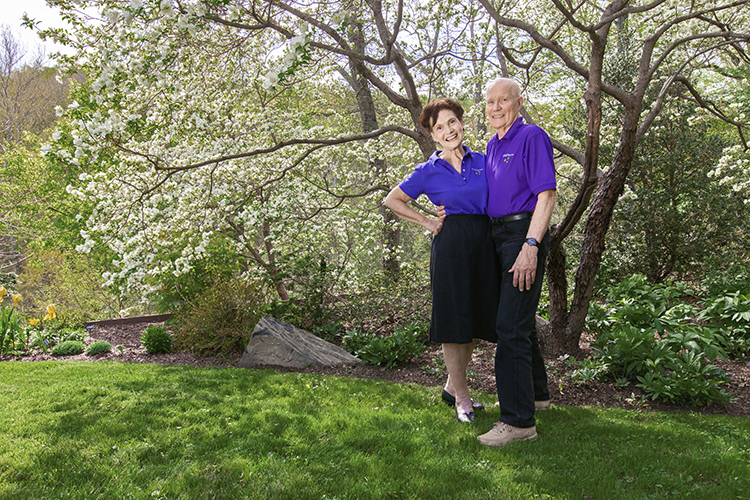Photo by Jared Gruenwald
by Brittany Barbato
Today, the Philadelphia region has more than 30 public gardens within 30 miles of Philadelphia, cultivating roots that ground much of America’s horticultural history. These four lesser-known gardens contain a treasure trove of beautiful, interesting and historically relevant plants waiting for you to discover and explore.
If you’re not careful, you just might miss the entrance to The Gardens at Mill Fleurs, marked only by cattle fencing and a small wooden sign off to the side of Cafferty Street in Point Pleasant, Pennsylvania. The garden is located amid sloped, rocky land, so turning onto the property feels like reaching the top of a roller coaster. After a winding journey upward, you can’t see much but you know you’re in for something spectacular.
Coast down the steep gravel driveway and the ride begins with thousands of rare plants arching overhead and bursting in bloom along pathways branching out from the main drive. Farther down the left side, the Tohickon Creek bubbles. At the end, a grist mill and a saw mill sit side-by-side. Originally built in the mid-1700s, the structures are now home to garden and furniture designers Barbara Tiffany, 76, and her husband, Harry Robert Tiffany III (“Tiff”), 78.
Barbara is a vivacious woman with permed brown hair, a small swoop of bangs curled perfectly over her right brow. She offers homemade oatmeal cranberry cookies and iced tea to guests, insisting that “being a good host is part of the experience.” Her graciousness is complemented by a certain inner strength that’s visible in her vigilant routine of ripping up stray weeds that threaten her “babies” or “pretty girls.”
Tiff is more soft-spoken than Barbara, but they both share an adventurous outlook on gardening and life that led them to purchase the property together nearly 25 years ago. The restoration and redesign process required a lot of tender loving care, something the couple feels has dual importance.
“The secret to success in gardening and relationships is to be open and willing to take risks, while also working hard and going the extra mile,” shares Barbara. After removing acres of rampant bamboo and cultivating the soil to a less-rocky state, they finally began to plant. “I just started buying cute, funky, different, interesting plants,” says Barbara. “And suddenly I had this collection that was very unusual.”
Today, the grounds feature more than 2,000 perennials, approximately 1,500 different varieties of woody plants and 1,000 hosta cultivars—among many other specimens. The garden is organized first and foremost by color, because Barbara believes it is the basic principle of design. “The driveway is pink,” says Barbara matter-of-factly as she points out the pink-tipped blossoms of a dogwood tree that resides among many other garden compatriots in similar shades. There are also green, bronze, purple and yellow beds; Patriot Hill is checkered in red, white and blue flora.
Other areas are named for common features: Garden Erotica is a bed full of plants with names like Summer Lovin’, Faithful Heart and Striptease; the “mini” garden has minuscule versions of plants found elsewhere on the grounds. The most prized area is the Jewel Box, a narrow, grassy path that harbors the greatest concentration of the Tiffanys’ favorite gems. There are approximately 10 varieties of jack-in-the-pulpit and at least 12 variations of Solomon’s seal, which features little white lantern-shaped flowers hanging under larger, variegated lily-esque leaves.
Toward the far side of the grounds is the outdoor “laboratory” of the head gardener, Joseph F. Novak. While Barbara dictates the design of the garden, Novak, a plantsman, artist and tinkering inventor, focuses on maintaining and improving the grounds’ health. His most notable tool is a biochar contraption, which looks like a metal barrel tucked into a pit of dirt and leaves. The slow burning of biomass (such as wood, leaves or infected plant waste) inside the barrel creates a charred substance that, when added to soil, stimulates important microorganisms that have been shown to enhance soil.
Whether it’s new types of sustainability practice, plant species or design ideas, Barbara says the goal of The Gardens at Mill Fleurs is to keep “gobbling up” and trying out “new anything” because the creativity and openness is what “keeps us feeling alive.” She hopes new garden visitors will be inspired to do the same: “I want to infect them and make them rebel against all the garden magazines that say this is what goes with this,” says Barbara. “You make up your own mind about what you like, and go do that!”
Hours: By appointment; or at 10:30 a.m. June 10 and 24 and July 8
Cost: $22 per person
The Secret Garden at Awbury Arboretum
Deep within the northeast corner of Awbury Arboretum, a simple black gate with a single gold lock is hugged by two arms of an expansive Wissahickon schist wall. Looking closely at the patterns in the wall is like looking at an illustration of Earth from outer space—oval-shaped slabs of bluish-gray swirl together with lumps of sand-colored sediment. Peek between the gate’s thin wrought-iron bars and you’ll see a wood-chipped path surrounded by flowering understory trees and shrubs such as winterberry holly, spicebush and dogwood. Look up, and you’re greeted by a variety of towering trees, including established persimmons with their alligator-skin bark.
The burgeoning area behind the gate and its walls was once a private garden for Margaret M. Cope, granddaughter of Henry Cope, who purchased Awbury in 1852. Today, this area is known as the Secret Garden and it will soon be an entirely natural playground for kids. Led by Bryan Hanes, a landscape architect and Awbury board member, the garden will remain connected to its historical context but feature new kid-friendly, natural elements such as climbing logs, dirt mounds and tree “cookies” (circular half-stumps of trees that kids can step, hop or sit on). As Hanes describes it, the space will offer “a high-quality, low-tech experience” for children to engage with each other and the environment through horticulture and geology, in addition to open play. The project is expected to be complete in time for its public grand celebration on Sept. 24.
“Nature can be a great teacher,” says Heather Zimmerman, Awbury’s director of programs and an education professional for more than 25 years. “It is calming, invites discovery, lends itself to physical exercise and engages us in appreciating our home, the Earth.” This spirit aligns with the Cope family, who spent much of their time cultivating and enjoying their land. In an unpublished memoir by Margaret Cope, she shares an outdoor childhood memory of her own: “Oh the joys of picking the violets out there, and the pink and white hawthorn, and the lilacs, and all sorts of blooming shrubbery. We used to sit and play, snapping off the violets’ heads by interlocking them.”
Hours: By appointment (open hours in progress)
Cost: Free
Wearing thick-rimmed, brown rectangular glasses and a trimmed beard, Joshua Darfler, greenhouse and garden manager at James G. Kaskey Memorial Park, is a self-declared “plant nerd” who says the park’s location is part of what makes the grounds so secretive. Who would think to look for a botanical garden amid the towering buildings on the University of Pennsylvania campus? Complete with a pollinator garden, fernery, woodlands and a weeping waterfall that flows into the garden’s beloved BioPo
nd, the space offers a living classroom to the university’s science community.
“You can start anywhere! Wander anywhere here,” says Darfler, “and you’ll always find something new.” His enthusiasm for botany overflows as he rattles off various research projects in progress: An ecology post-doc student is looking at potential uses of phytoremediation on contaminated soils; a physics class is growing passion flowers and spathiphyllum so they can collect flower buds to look at pollen microstructure development; a recently acquired live oak from northern Virginia, which shouldn’t survive in Philadelphia’s plant-hardiness zone, is offering the biology and botany departments a glimpse into climate change science. “Our founders were pushing the zones, so it’s exciting to carry that work on in a way,” says Darfler. “But we’re also viewing it through a different lens now. We’re thinking, ‘Maybe this will be the flora here in 20 to 30 years and maybe this live oak will be the new street tree.’”
Beyond its education purposes, the park serves as a passageway and reprieve for anyone who discovers it. Nurses in scrubs power walk through to their next shift; businesspeople in sharp suits and shiny shoes hustle to meetings; and, as expected, gaggles of college students stream in during afternoon breaks between classes. Nearby preschools often walk students over for lunch, too. Sometimes, the tiny tots stop mid-play to offer unsolicited help to Darfler and his team as they weed.
“Every part of our garden has something magical,” adds Paula Kwasniewska, the park’s seasonal gardener. “This is a special place, and whoever travels through it, at any age, feels it.”
Hours: Sunrise to sunset
Cost: Free
This garden is a darling plot of land adjacent to the historic Wyck House in the heart of Germantown. Walk down the avenue between Walnut and High streets on any given sunny day between early summer and fall, and you’ll likely smell the garden before you actually see it. The sweet, billowing fragrance of more than 50 cultivars of fresh roses waft over the fence and into the neighborhood.
Widely recognized as America’s oldest rose garden in original plan, it maintains both the original layout and original rose specimens first planted in the 1820s. Several parterres, or quilted compartments, follow a symmetrical pattern. Traditionally, each section would also be framed by perfectly pruned boxwood hedges with their classic green oval leaves. Boxwood blight forced Wyck to remove most of the hedges for the time being, though, giving the garden a slightly overgrown feel. When in bloom, the garden is a vision of pillowy petals popping out of greenery and climbing up walls of lattice.
Perhaps the most enchanting part of the garden, though, are the stories and mysteries about the roses. Several roses in cultivation today were thought lost until they were discovered growing at Wyck, and all specimens of those varieties in commercial trade descend from Wyck plants. Rumor has it the hybrid multiflora rose, Rosa “Lauré Davoust,” was nowhere to be found until a wooden trellis was restored in its original location, allegedly waking the rose up from it long slumber and enticing it to stretch its limbs toward the sun.
Hours: Noon to 4 p.m. on Thursdays, Fridays and Saturdays
Cost: Free




